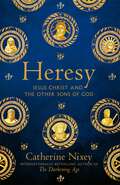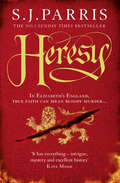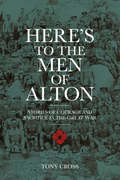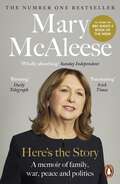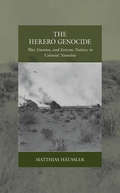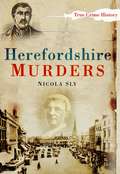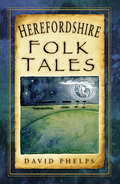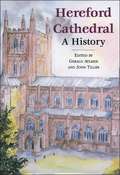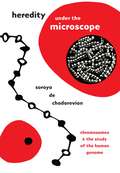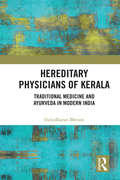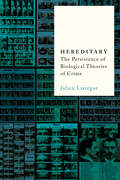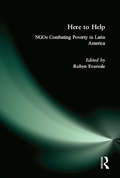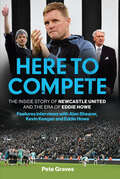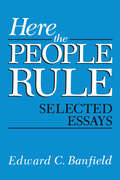- Table View
- List View
Heresy: Jesus Christ and the Other Sons of God
by Catherine Nixey‘In the beginning was the Word,’ says the Gospel of John. This sentence – and the words of all four gospels – is central to the teachings of the Christian church and has shaped Western art, literature and language, and the Western mind.Yet in the years after the death of Christ there was not merely one word, nor any consensus as to who Jesus was or why he had mattered. There were many different Jesuses, among them the aggressive Jesus who scorned his parents and crippled those who opposed him, the Jesus who sold his twin into slavery and the Jesus who had someone crucified in his stead.Moreover, in the early years of the first millennium there were many other saviours, many sons of gods who healed the sick and cured the lame. But as Christianity spread, they were pronounced unacceptable – even heretical – and they faded from view. Now, in Heresy, Catherine Nixey tells their extraordinary story, one of contingency, chance and plurality. It is a story about what might have been.
Heresy: Heresy, Prophecy, Sacrilege (Giordano Bruno #1)
by S. ParrisThe first book in the No. 1 Sunday Times bestselling series following Giordano Bruno, set at the time of Queen Elizabeth I
Here's to the Men of Alton: Stories of Courage and Sacrifice in the Great War
by Tony CrossDuring the Great War almost 650 men enlisted from the small market town of Alton, Hampshire. These soldiers served all over the globe, including the Western Front, India, Mesopotamia, Salonika, Turkey and Russia, and were never the same again; some choosing to tell their stories, others desperately trying to forget what they had experienced. But they were the lucky ones: around a third of those who left for distant shores were never to return and instead lie buried in cemeteries across the world. The stories these men couldn’t tell themselves are uncovered here as a monument to their bravery and sacrifice. Here’s to the Men of Alton is a collection of personal accounts of courage and hardship which provides a lasting tribute to those ordinary men who gave their lives for King and Country.
Here’s the Story: A Memoir
by Mary McAleeseThe groundbreaking two-term President of Ireland tells the stories of her lifeWhen a young Mary McAleese told a priest that she planned to become a lawyer, the priest dismissed the idea: she knew no one in the law, and she was female. The reality of what she went on to achieve - despite those obstacles, and despite a sectarian attack that forced her family to flee their home - is even more improbable.In this luminous memoir, Mary McAleese traces that astonishing arc: from the tight streets of north Belfast, to a professorship in Dublin while still in her twenties, behind-the-scenes work on the peace process, and two triumphant terms as President of Ireland. She writes of her encounters with prime ministers, popes and royalty with the same easy candour and intimacy with which she describes her childhood. And her account of the latest act in her remarkable career - quietly pursuing a doctorate, and loudly opposing the misogyny of the Catholic Church - is inspiring.Here's the Story is warm, witty, often surprising and relentlessly fascinating: an extraordinarily intimate memoir by one of the most remarkable public figures of our time.
The Herero Genocide: War, Emotion, and Extreme Violence in Colonial Namibia (War and Genocide #31)
by Matthias HäusslerDrawing on previously inaccessible and overlooked archival sources, The Herero Genocide undertakes a groundbreaking investigation into the war between colonizer and colonized in what was formerly German South-West Africa and is today the nation of Namibia. In addition to its eye-opening depictions of the starvation, disease, mass captivity, and other atrocities suffered by the Herero, it reaches surprising conclusions about the nature of imperial dominion, showing how the colonial state’s genocidal posture arose from its own inherent weakness and military failures. The result is an indispensable account of a genocide that has been neglected for too long.
The Herero Genocide: War, Emotion, and Extreme Violence in Colonial Namibia (War and Genocide #31)
by Matthias HäusslerDrawing on previously inaccessible and overlooked archival sources, The Herero Genocide undertakes a groundbreaking investigation into the war between colonizer and colonized in what was formerly German South-West Africa and is today the nation of Namibia. In addition to its eye-opening depictions of the starvation, disease, mass captivity, and other atrocities suffered by the Herero, it reaches surprising conclusions about the nature of imperial dominion, showing how the colonial state’s genocidal posture arose from its own inherent weakness and military failures. The result is an indispensable account of a genocide that has been neglected for too long.
The Herero Genocide: War, Emotion, and Extreme Violence in Colonial Namibia (War and Genocide #31)
by Matthias HäusslerDrawing on previously inaccessible and overlooked archival sources, The Herero Genocide undertakes a groundbreaking investigation into the war between colonizer and colonized in what was formerly German South-West Africa and is today the nation of Namibia. In addition to its eye-opening depictions of the starvation, disease, mass captivity, and other atrocities suffered by the Herero, it reaches surprising conclusions about the nature of imperial dominion, showing how the colonial state’s genocidal posture arose from its own inherent weakness and military failures. The result is an indispensable account of a genocide that has been neglected for too long.
The Herero Genocide: War, Emotion, and Extreme Violence in Colonial Namibia (War and Genocide #31)
by Matthias HäusslerDrawing on previously inaccessible and overlooked archival sources, The Herero Genocide undertakes a groundbreaking investigation into the war between colonizer and colonized in what was formerly German South-West Africa and is today the nation of Namibia. In addition to its eye-opening depictions of the starvation, disease, mass captivity, and other atrocities suffered by the Herero, it reaches surprising conclusions about the nature of imperial dominion, showing how the colonial state’s genocidal posture arose from its own inherent weakness and military failures. The result is an indispensable account of a genocide that has been neglected for too long.
Herefordshire Murders
by Nicola SlyHerefordshire Murders brings together twenty-eight murderous tales, some which were little known outside the county and others which made national headlines. Herefordshire was home to one of Britain’s most infamous murderers, Major Herbert Rowse Armstrong, who, in 1921, poisoned his wife and attempted to poison a fellow solicitor in Hay-on-Wye. However, the county has also experienced many lesser known murders. They include the case of two-year-old Walter Frederick Steers, brutally killed in Little Hereford in 1891; eighty-seven-year-old Phillip Ballard, who died at the hands of two would-be burglars in Tupsley in 1887; Jane Haywood, murdered by her husband near Leominster in 1903; and the shooting of two sisters at Burghill Court, near Hereford, by their butler in 1926. Nicola Sly’s carefully researched and enthralling text will appeal to everyone interested in the shady side of Herefordshire’s history.
Herefordshire Folk Tales (Folk Tales Ser.)
by David PhelpsThis selection of thirty folk tales and legends from the deepest corners of Herefordshire reflect the wit and wisdom of the countryside and its people. There are strange happenings in the peaceful county, formed from early attempts to explain the natural and spiritual world, as well as dark tales of revenge resulting from clashes on the Welsh Borders. From the Saxon king of East Anglia who became the patron saint of Hereford Cathedral, and the story of the black hound of Hergest Court which inspired Arthur Conan Doyle, to a medieval love story, these gripping tales have stood the test of time, and remain classic texts which will be enjoyed time and again by modern readers.
Hereford Cathedral
by Gerarld AlymerUnique in its possession of a chained library and of the Mappa Mundi, Hereford Cathedral is remarkable for its architecture, its long history and its musical tradition. "Hereford Cathedral" is the definitive account of its history from Anglo-Saxon times to the present, and of its architecture, fittings, musical tradition, archives and library. Substantial parts of the structure date from Norman times, but the building has been modified in many ways over the years. In the middle ages Hereford was the centre of pilgrimage to the shrine of St. Thomas Cantilupe, bishop of Hereford (d.1282). It survived the Reformation relatively intact, but was damaged during the Civil War. Its west end collapsed disastrously in 1786, leading to the renewal and reworking of the exterior by James Wyatt. Little was changed in the interior until the striking Victorian rationalisation by George Gilbert Scott.
Heredity under the Microscope: Chromosomes and the Study of the Human Genome
by Soraya de ChadarevianBy focusing on chromosomes, Heredity under the Microscope offers a new history of postwar human genetics. Today chromosomes are understood as macromolecular assemblies and are analyzed with a variety of molecular techniques. Yet for much of the twentieth century, researchers studied chromosomes by looking through a microscope. Unlike any other technique, chromosome analysis offered a direct glimpse of the complete human genome, opening up seemingly endless possibilities for observation and intervention. Critics, however, countered that visual evidence was not enough and pointed to the need to understand the molecular mechanisms. Telling this history in full for the first time, Soraya de Chadarevian argues that the often bewildering variety of observations made under the microscope were central to the study of human genetics. Making space for microscope-based practices alongside molecular approaches, de Chadarevian analyzes the close connections between genetics and an array of scientific, medical, ethical, legal, and policy concerns in the atomic age. By exploring the visual evidence provided by chromosome research in the context of postwar biology and medicine, Heredity under the Microscope sheds new light on the cultural history of the human genome.
Heredity under the Microscope: Chromosomes and the Study of the Human Genome
by Soraya de ChadarevianBy focusing on chromosomes, Heredity under the Microscope offers a new history of postwar human genetics. Today chromosomes are understood as macromolecular assemblies and are analyzed with a variety of molecular techniques. Yet for much of the twentieth century, researchers studied chromosomes by looking through a microscope. Unlike any other technique, chromosome analysis offered a direct glimpse of the complete human genome, opening up seemingly endless possibilities for observation and intervention. Critics, however, countered that visual evidence was not enough and pointed to the need to understand the molecular mechanisms. Telling this history in full for the first time, Soraya de Chadarevian argues that the often bewildering variety of observations made under the microscope were central to the study of human genetics. Making space for microscope-based practices alongside molecular approaches, de Chadarevian analyzes the close connections between genetics and an array of scientific, medical, ethical, legal, and policy concerns in the atomic age. By exploring the visual evidence provided by chromosome research in the context of postwar biology and medicine, Heredity under the Microscope sheds new light on the cultural history of the human genome.
Heredity under the Microscope: Chromosomes and the Study of the Human Genome
by Soraya de ChadarevianBy focusing on chromosomes, Heredity under the Microscope offers a new history of postwar human genetics. Today chromosomes are understood as macromolecular assemblies and are analyzed with a variety of molecular techniques. Yet for much of the twentieth century, researchers studied chromosomes by looking through a microscope. Unlike any other technique, chromosome analysis offered a direct glimpse of the complete human genome, opening up seemingly endless possibilities for observation and intervention. Critics, however, countered that visual evidence was not enough and pointed to the need to understand the molecular mechanisms. Telling this history in full for the first time, Soraya de Chadarevian argues that the often bewildering variety of observations made under the microscope were central to the study of human genetics. Making space for microscope-based practices alongside molecular approaches, de Chadarevian analyzes the close connections between genetics and an array of scientific, medical, ethical, legal, and policy concerns in the atomic age. By exploring the visual evidence provided by chromosome research in the context of postwar biology and medicine, Heredity under the Microscope sheds new light on the cultural history of the human genome.
Heredity under the Microscope: Chromosomes and the Study of the Human Genome
by Soraya de ChadarevianBy focusing on chromosomes, Heredity under the Microscope offers a new history of postwar human genetics. Today chromosomes are understood as macromolecular assemblies and are analyzed with a variety of molecular techniques. Yet for much of the twentieth century, researchers studied chromosomes by looking through a microscope. Unlike any other technique, chromosome analysis offered a direct glimpse of the complete human genome, opening up seemingly endless possibilities for observation and intervention. Critics, however, countered that visual evidence was not enough and pointed to the need to understand the molecular mechanisms. Telling this history in full for the first time, Soraya de Chadarevian argues that the often bewildering variety of observations made under the microscope were central to the study of human genetics. Making space for microscope-based practices alongside molecular approaches, de Chadarevian analyzes the close connections between genetics and an array of scientific, medical, ethical, legal, and policy concerns in the atomic age. By exploring the visual evidence provided by chromosome research in the context of postwar biology and medicine, Heredity under the Microscope sheds new light on the cultural history of the human genome.
Heredity under the Microscope: Chromosomes and the Study of the Human Genome
by Soraya de ChadarevianBy focusing on chromosomes, Heredity under the Microscope offers a new history of postwar human genetics. Today chromosomes are understood as macromolecular assemblies and are analyzed with a variety of molecular techniques. Yet for much of the twentieth century, researchers studied chromosomes by looking through a microscope. Unlike any other technique, chromosome analysis offered a direct glimpse of the complete human genome, opening up seemingly endless possibilities for observation and intervention. Critics, however, countered that visual evidence was not enough and pointed to the need to understand the molecular mechanisms. Telling this history in full for the first time, Soraya de Chadarevian argues that the often bewildering variety of observations made under the microscope were central to the study of human genetics. Making space for microscope-based practices alongside molecular approaches, de Chadarevian analyzes the close connections between genetics and an array of scientific, medical, ethical, legal, and policy concerns in the atomic age. By exploring the visual evidence provided by chromosome research in the context of postwar biology and medicine, Heredity under the Microscope sheds new light on the cultural history of the human genome.
Heredity under the Microscope: Chromosomes and the Study of the Human Genome
by Soraya de ChadarevianBy focusing on chromosomes, Heredity under the Microscope offers a new history of postwar human genetics. Today chromosomes are understood as macromolecular assemblies and are analyzed with a variety of molecular techniques. Yet for much of the twentieth century, researchers studied chromosomes by looking through a microscope. Unlike any other technique, chromosome analysis offered a direct glimpse of the complete human genome, opening up seemingly endless possibilities for observation and intervention. Critics, however, countered that visual evidence was not enough and pointed to the need to understand the molecular mechanisms. Telling this history in full for the first time, Soraya de Chadarevian argues that the often bewildering variety of observations made under the microscope were central to the study of human genetics. Making space for microscope-based practices alongside molecular approaches, de Chadarevian analyzes the close connections between genetics and an array of scientific, medical, ethical, legal, and policy concerns in the atomic age. By exploring the visual evidence provided by chromosome research in the context of postwar biology and medicine, Heredity under the Microscope sheds new light on the cultural history of the human genome.
Hereditary Physicians of Kerala: Traditional Medicine and Ayurveda in Modern India
by Indudharan MenonThis book examines the history and evolution of Ayurveda and other indigenous medical traditions in juxtaposition with their encounter with colonial modernity. Through the lens of hereditary folk and Ayurvedic practitioners, it focuses on Kerala’s heterogeneous medical traditions and presents them against the backdrop of the geographical, historical, sociocultural, ethnographic and regional contexts in which they developed and transformed. The author explores the world of Kerala’s last traditionally trained hereditary practitioners (folk healers, poison therapists, Sanskrit-speaking Muslim Ayurvedic practitioners and the legendary Brahman Ashtavaidyan physicians). He discusses the views of these physicians regarding the marked difference between their personalised ancestral methods of treatment and the standardised version of Ayurveda compliant with biomedicine that is practised by doctors today. Drawing on extensive fieldwork, this book will be useful to researchers and scholars of medical anthropology, health and social medicine, sociology and social anthropology, the history of science and modern Indian history, as well as to medical practitioners interested in alternative and traditional medicine.
Hereditary Physicians of Kerala: Traditional Medicine and Ayurveda in Modern India
by Indudharan MenonThis book examines the history and evolution of Ayurveda and other indigenous medical traditions in juxtaposition with their encounter with colonial modernity. Through the lens of hereditary folk and Ayurvedic practitioners, it focuses on Kerala’s heterogeneous medical traditions and presents them against the backdrop of the geographical, historical, sociocultural, ethnographic and regional contexts in which they developed and transformed. The author explores the world of Kerala’s last traditionally trained hereditary practitioners (folk healers, poison therapists, Sanskrit-speaking Muslim Ayurvedic practitioners and the legendary Brahman Ashtavaidyan physicians). He discusses the views of these physicians regarding the marked difference between their personalised ancestral methods of treatment and the standardised version of Ayurveda compliant with biomedicine that is practised by doctors today. Drawing on extensive fieldwork, this book will be useful to researchers and scholars of medical anthropology, health and social medicine, sociology and social anthropology, the history of science and modern Indian history, as well as to medical practitioners interested in alternative and traditional medicine.
Hereditary: The Persistence of Biological Theories of Crime
by Julien LarregueSince the 1990s, a growing number of criminal courts around the world have been using expert assessments based on behavioral genetics and neuroscience to evaluate the responsibility and dangerousness of offenders. Despite this rapid circulation, however, we still know very little about the scientific knowledge underlying these expert evaluations. Hereditary traces the historical development of biosocial criminology in the United States from the 1960s to the present, showing how the fate of this movement is intimately linked to that of the field of criminology as a whole. In claiming to identify the biological and environmental causes of so-called "antisocial" behaviors, biosocial criminologists are redefining the boundary between the normal and the pathological. Julien Larregue examines what is at stake in the development of biosocial criminology. Beyond the origins of delinquency, Larregue addresses the reconfiguration of expertise in contemporary societies, and in particular the territorial struggles between the medical and legal professions. For if the causes of crime are both biological and social, its treatment may call for medical as well as legal solutions.
Hereditary: The Persistence of Biological Theories of Crime
by Julien LarregueSince the 1990s, a growing number of criminal courts around the world have been using expert assessments based on behavioral genetics and neuroscience to evaluate the responsibility and dangerousness of offenders. Despite this rapid circulation, however, we still know very little about the scientific knowledge underlying these expert evaluations. Hereditary traces the historical development of biosocial criminology in the United States from the 1960s to the present, showing how the fate of this movement is intimately linked to that of the field of criminology as a whole. In claiming to identify the biological and environmental causes of so-called "antisocial" behaviors, biosocial criminologists are redefining the boundary between the normal and the pathological. Julien Larregue examines what is at stake in the development of biosocial criminology. Beyond the origins of delinquency, Larregue addresses the reconfiguration of expertise in contemporary societies, and in particular the territorial struggles between the medical and legal professions. For if the causes of crime are both biological and social, its treatment may call for medical as well as legal solutions.
Here to Help: NGOs Combating Poverty in Latin America
by Robyn EversoleOver six billion dollars in developmental assistance is funneled annually through non-governmental organizations (NGOs), yet little is understood about the nature of their relationship with communities and the real impact of their work. This book examines what role NGOs really play in fighting poverty in Latin America. Expert NGO professionals and scholars explore grass-roots relationships between international religious and secular NGOs and poor communities. They probe the power structures, cultural assumptions, dangers and possibilities that underlie NGOs' work. While fighting poverty is the mission of many NGOs, most are aware that they often fail to make things better, and, in fact, may make things worse. By providing a forum for Northern and Southern NGOs, donors, scholars, and poor people themselves, this book explores the causes and cures of poverty, and presses at the boundaries of our understanding of participatory development. It identifies both internal and external factors that influence the success of NGO projects, and moves beyond standard best-practice theory to probe more deeply the relationships that underlie poverty and how these relationships can be shifted to achieve solutions.
Here to Help: NGOs Combating Poverty in Latin America
by Robyn EversoleOver six billion dollars in developmental assistance is funneled annually through non-governmental organizations (NGOs), yet little is understood about the nature of their relationship with communities and the real impact of their work. This book examines what role NGOs really play in fighting poverty in Latin America. Expert NGO professionals and scholars explore grass-roots relationships between international religious and secular NGOs and poor communities. They probe the power structures, cultural assumptions, dangers and possibilities that underlie NGOs' work. While fighting poverty is the mission of many NGOs, most are aware that they often fail to make things better, and, in fact, may make things worse. By providing a forum for Northern and Southern NGOs, donors, scholars, and poor people themselves, this book explores the causes and cures of poverty, and presses at the boundaries of our understanding of participatory development. It identifies both internal and external factors that influence the success of NGO projects, and moves beyond standard best-practice theory to probe more deeply the relationships that underlie poverty and how these relationships can be shifted to achieve solutions.
Here to Compete: The Inside Story of Newcastle United and the Era of Eddie Howe
by Pete GravesThe quintessential book for Newcastle United fans everywhere, Sky Sports presenter Pete Graves tells the inside story of the Magpies today, using exclusive interviews with Eddie Howe and other club legends.Welcome to Newcastle United, the most exciting football club in the world right now.Since joining the team in 2021, Eddie Howe has been determined to transform Newcastle United from a perennial underachiever into one of the biggest teams in not just the Premier League, but Europe as well. With the players, fans and decision-makers finally all working together, and with the pain of the past behind them, the Magpies are ready for a new era to begin...Telling the story of Newcastle through some of its most competitive moments, including Kevin Keegan and Bobby Robson's stewardships, as well as touching on some of its trickier times, television presenter and diehard fan Pete Graves recaps the team's history and goes inside the club to show what is so exciting about this team today.Featuring interviews with key figures past and present, including Eddie Howe himself, Graves builds a picture of what's happening with Newcastle, both on and off the pitch, as they climb the league and set their sights on silverware.With extensive research and unparalleled access, Here to Compete is the incredible story of a team reborn and the man who is on course to build an empire.
Here the People Rule: Selected Essays (Boston Studies in the Philosophy and History of Science)
by Edward BanfieldMost of the essays in this volume have appeared in scholarly journals or in books edited by others. A few are published here for the first time. None has been taken from one of my books. A would-be reader would have to go to much trouble to find them; that is the reason for bringing them together. Collections of essays are frequently miscellanies. This one is not. Except for the final two chapters, all deal with some aspect of the American political system. Some have to do with the structure and functioning of the federal system, others with the nature of publi(}-and incidentally other-organization, and still others with the causes and supposed cures of the social problems that government is nowadays expected to solve or cope with. The two final chapters are about the relationship between economics and political science; for lack of a better term they may be methodological.
